Our research
Nanobubbles at interfaces
Drag-reducing surfaces
We are interested in identifying the interfacial properties that promote interfacial slip. Coatings the promote slip essentially lubricate the flow of liquids across the surface, reducing the pressure required to drive the flow. Interfacial slip has important consequences for liquid flow in confined geometries, such as in microfluidics devices, porous media or blood vessels.
To study interfacial slip at the nanoscale, we squeeze tiny films out of a gap between a microsphere and a flat surface in an atomic force microscope (AFM) measurement. To study the phenomena at the microscale, we test our lubricant-infused surfaces in microfluidics channels to study their drag-reducing properties. These experiments lead us to…
An exciting discovery
Recent studies by our group have demonstrated the spontaneous nucleation of nanobubbles on the surface of lubricant-infused wrinkled substrates and that these, and not the lubricant per se, are responsible for the remarkable drag reduction often reported for these surfaces. The mechanism by which oil-coated surfaces become enriched by nanobubbles is not understood. We are currently studying the nucleation of nanobubbles using atomic force microscopy meniscus force mapping and laser scanning confocal microscopy.
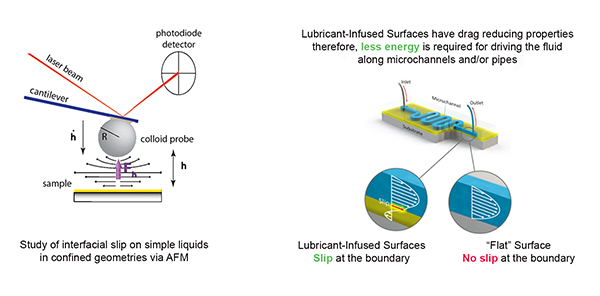

References
- C. Vega-Sánchez, C. Neto*; “Slightly Depleted Lubricant-infused Surfaces Are No Longer Slippery”, Langmuir (2022) https://doi.org/10.1021/acs.langmuir.2c01412 (IF = 4.33)
- S. Peppou-Chapman, C. Vega-Sanchez, C. Neto*; “Detection of Nanobubbles on Lubricant-Infused Surfaces Using AFM Meniscus Force Measurements”, Langmuir 10.1021/acs.langmuir.2c01411 (2022).(IF = 4.33)
- Vega-Sánchez, C; Peppou-Chapman, S; Zhu, L; Neto, C*; “Nanobubbles explain the large slip observed on lubricant-infused surfaces” Nature Comm.. 13, 351 (2022). DOI:10.1038/s41467-022-28016-1 (IF=17.7) Highlighted by the Editor, 26 Jan 2022.
- Lee, T.; Charrault, E.; Neto, C. Interfacial slip on rough, patterned and soft surfaces: A review of experiments and simulations. Adv. Colloid Interface Sci. 2014, 210, 21-38. https://www.sciencedirect.com/science/article/pii/S0001868614000724?via%3Dihub
- Zhu, L.; Neto, C.; Attard, P. Reliable measurements of interfacial slip by colloid probe atomic force microscopy. III. Shear-rate-dependent slip. Langmuir 2012, 28 (7), 3465-3473. https://pubs.acs.org/doi/abs/10.1021/la204566h
- Zhu, L.; Attard, P.; Neto, C. Reliable measurements of interfacial slip by colloid probe atomic force microscopy. II. Hydrodynamic force measurements. Langmuir 2011, 27 (11), 6712-6719. https://pubs.acs.org/doi/abs/10.1021/la104597dZhu, L.; Attard, P.; Neto, C. Reliable measurements of interfacial slip by colloid probe atomic force microscopy. I. Mathematical modeling. Langmuir 2011, 27 (11), 6701-6711. https://pubs.acs.org/doi/abs/10.1021/la2007809
Slippery, covalently attached liquid surfaces
Slippery covalently attached liquid surfaces (SCALS) have recently attracted attention due to their exquisite wetting properties, namely their low contact angle hysteresis (CAH) and anti-fouling characteristics.
Why are SCALS slippery?
Although the SCALS phenomenon is generally attributed to the liquid-like mobility of the thin layer of tethered liquid polymer, the underlying dynamics and physicochemical parameters that produce these desirable properties are poorly understood.
The Neto group has characterised the physicochemical structure of polydimethylsiloxane SCALS prepared using established methods [5-8]. We employ single-molecule force spectroscopy and neutron reflectometry (interpreted using numerical self-consistent field theory) to quantify the chain length, polydispersity, thickness, and grafting density of the SCALS.
This allows us to better design these exciting surfaces.
Water capture with SCALS
The capture of moisture from the atmosphere through condensation has the potential to provide a sustainable source of water. Here, we investigate condensation in conditions similar to those of natural dew capture and explore how contact angle and contact angle hysteresis affect water capture rates. We compare water collection on both hydrophilic and hydrophobic slippery covalently attached liquids, as well as on conventional hydrophilic, high-hysteresis substrates.
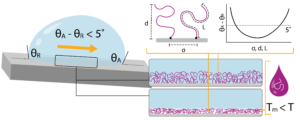
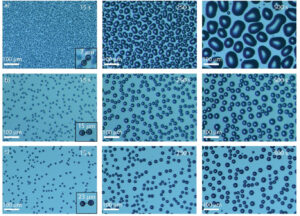
References
- I.J. Gresham, S. G. Lilley, A. R. J. Nelson, K. Koynov, C. Neto; “Nanostructure Explains the Behavior of Slippery Covalently Attached Liquid Surfaces” Angewandte Chemie (2023) 10.1002/anie.202308008 (IF=16.6)
- I.J. Gresham, C. Neto; “Advances and challenges in slippery covalently-attached liquid surfaces” Adv. Colloid Interface Sci. (2023) 10.1016/j.cis.2023.102906 (IF=15.2)
- A. Katselas, I. J. Gresham, A. R. J. Nelson, C. Neto “Exploring the water capture efficiency of covalently attached liquid-like surfaces” J. Chem. Phys. (2023)10.1063/5.0146847 (IF=4.3)
Nanotextured surfaces
We pioneered a technique involving nanoscale wrinkles to create nanotextured surfaces and infused them with a viscous lubricant to fabricate slippery liquid-infused surfaces. The wrinkled surfaces can be fabricated to be superhydrophobic in air, superoleophobic underwater and superhydrophobic under oil. Our technique allows patterning at length-scales from a few hundred nanometers to several tens of micrometers in a manner that is simple, cost-effective, and rapid.
Bioinspired anti-fouling surfaces
Using our nanotextured wrinkled polymer surface, we mimic the lubricating mechanism of the pitcher plant. When infused with lubricant, our wrinkled surface traps the lubricant and becomes slippery; thereby functioning as a bioinspired anti-fouling surface with demonstrated ability to inhibit the attachment of bacteria in vitro and marine fouling in the ocean for up to 7 weeks.
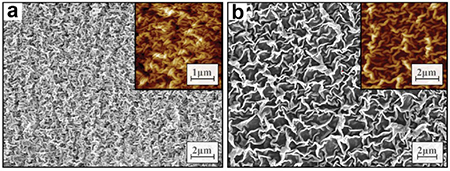
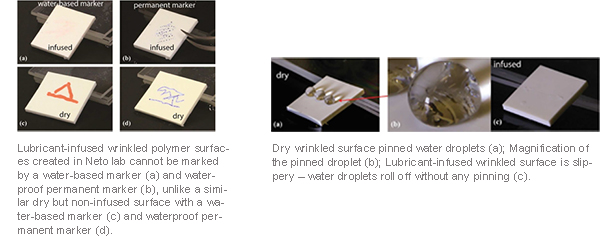
References
- Peppou-Chapman, S; Hong, JK; Waterhouse, A and Neto, C. Life and death of liquid-infused surfaces: A review on the choice, analysis and fate of the infused liquid layer Chemical Society Reviews, 49, (11), 3688-3715, 2020. DOI: 10.1039/d0cs00036a
- Ware, C. S.; Smith-Palmer, T.; Peppou-Chapman, S.; Scarratt, L. R. J.; Humphries, E. M.; Balzer, D.; Neto, C. Marine antifouling behavior of lubricant-infused nanowrinkled polymeric surfaces. ACS Applied Materials & Interfaces 2018, 10 (4), 4173-4182. https://pubs.acs.org/doi/10.1021/acsami.7b14736
- Peppou-Chapman, S.; Neto, C. Mapping depletion of lubricant films on anti-biofouling wrinkled slippery surfaces. ACS Applied Materials & Interfaces 2018. https://pubs.acs.org/doi/10.1021/acsami.8b11768
- Owais, A.; Smith-Palmer, T.; Gentle, A.; Neto, C. Influence of long-range forces and capillarity on the function of underwater superoleophobic wrinkled surfaces. Soft Matter 2018, 14 (32), 6627-6634. https://pubs.rsc.org/en/content/articlehtml/2018/sm/c8sm00709h
- Scarratt, L. R.; Hoatson, B. S.; Wood, E. S.; Hawkett, B. S.; Neto, C. Durable superhydrophobic surfaces via spontaneous wrinkling of teflon AF. ACS applied materials & interfaces 2016, 8 (10), 6743-6750. https://pubs.acs.org/doi/abs/10.1021/acsami.5b12165
Pattern formation via thin film dewetting
The Neto group pioneered a spontaneous patterning technique via dewetting of thin liquid films, particularly dewetting of polymer bilayers. This is based on the understanding of the intermolecular forces and spreading parameter that make thin liquid films stable.
Thin polymer film dewetting has many advantages over other patterning techniques such as micro-contact printing, photolithography and patterned plasma deposition as it is
- Simple
- Cost effective – the polymers that can be used to produce functional patterns are many, low cost and easily (often commercially) available
- Versatile – no restriction on the choice of polymers used to fabricate the bilayers
- Scalable and easy control on the dimension of the patterns
Water capture
We harness our polymer dewetting technique to create micro- and nano-patterns that passively capture water from the atmosphere. Our pattern generation approach is intrinsically up-scalable, and it could be applied to large three-dimensional objects. This technology could lead to the delocalised, large-scale capture of water for use for drinking, irrigation, and animals.

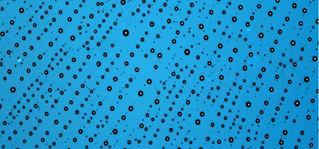
References
- Chiu, M.; Wood, J. A.; Widmer-Cooper, A.; Neto, C. Aligned droplet patterns by dewetting of polymer bilayers. Macromolecules 2018, 51 (15), 5485-5493. https://pubs.acs.org/doi/10.1021/acs.macromol.8b00620
- Telford, A. M.; Thickett, S. C.; Neto, C. Functional patterned coatings by thin polymer film dewetting. J. Colloid Interface Sci. 2017, 507, 453-469. https://www.sciencedirect.com/science/article/pii/S0021979717307749
- Al-Khayat, O.; Hong, J. K.; Beck, D. M.; Minett, A. I.; Neto, C. Patterned polymer coatings increase the efficiency of dew harvesting. ACS applied materials & interfaces 2017, 9 (15), 13676-13684. https://pubs.acs.org/doi/abs/10.1021/acsami.6b16248
- Al-Khayat, O.; Geraghty, K.; Shou, K.; Nelson, A.; Neto, C. Chain collapse and interfacial slip of polystyrene films in good/nonsolvent vapor mixtures. Macromolecules 2016, 49 (4), 1344-1352. https://pubs.acs.org/doi/abs/10.1021/acs.macromol.5b02253
Self-assembled monolayer of perfluorinated molecules
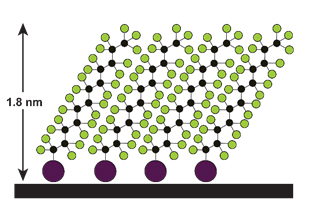
References
- Shou, K; Hong, JK; Wood, ES; Hook, JM; Nelson, A; Yin, Y; Andersson, GG; Abate, A; Steiner, U and Neto, C. Ultralow surface energy self-assembled monolayers of iodo-perfluorinated alkanes on silica driven by halogen bonding. Nanoscale, 11 (5), 2401-2411, 2019. DOI: 10.1039/c8nr08195f
- Abate, A.; Dehmel, R.; Sepe, A.; Nguyen, N. L.; Roose, B.; Marzari, N.; Hong, J. K.; Hook, J. M.; Steiner, U.; Neto, C. Halogen-bond driven self-assembly of perfluorocarbon monolayers on silicon nitride. Journal of Materials Chemistry A, 7 (42), 24445-24453, 2019. DOI: 10.1039/c9ta04620h
- Abate, A.; Dehmel, R.; Sepe, A.; Nguyen, N. L.; Roose, B.; Marzari, N.; Hong, J. K.; Hook, J. M.; Steiner, U.; Neto, C. Halogen-bond driven self-assembly of perfluorocarbon monolayers. arXiv preprint arXiv:1803.05672 2018. https://arxiv.org/abs/1803.05672

